Food Science Experiments
These food science experiments are to teach kids about science in the kitchen. The activities are designed for kids to do with an adult's supervision and/or help depending on their age.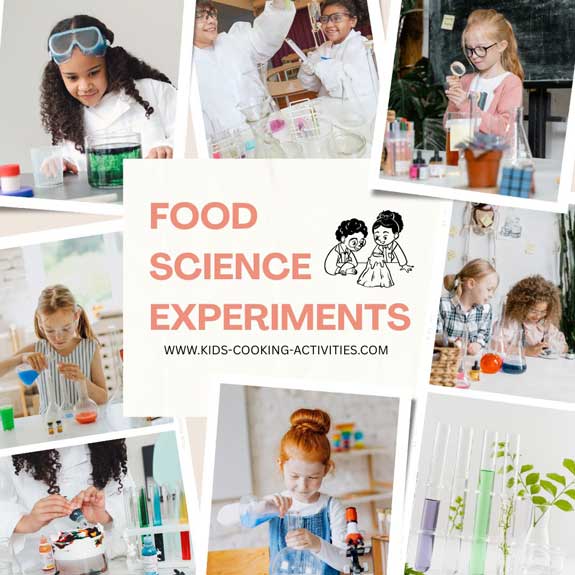
We have two sections one for younger chefs and one for older chefs. Younger chef projects are great for elementary and preschool age. However with an adult's help any age group would enjoy all the experiments in kitchen science.
Kids Cooking Activities Teaching Materials
Make teaching easier with our activities and recipes compiled in theme sets and books with an easy to read formatPerfect for teaching!
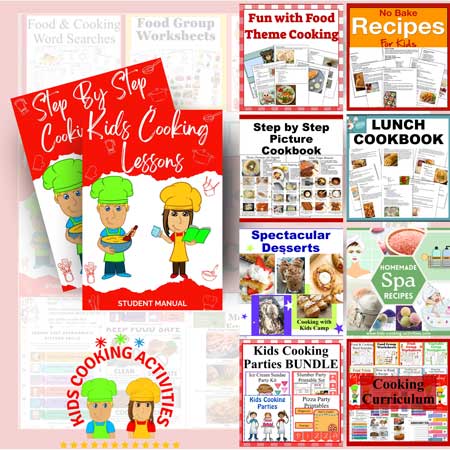
~This post may contain affiliate links and I'll earn a small commission if you shop through them. There is no extra cost to you. This is how we help support our family and continue to bring you amazing content. To learn more see the affiliates disclosure here.~
Science Lessons in the Kitchen
Some basic science lessons when cooking in the kitchen are:- Discovering food groups
- Making predictions
- Experimenting
- Learning how food grows
- Learning how food changes while cooking
- Working with five senses. Sensory exploration-with hands on and feeling the ingredients while cooking
- For older kids, cooking can provide opportunities to predict, analyze and experiment.
We've gathered up and researched our own kitchen science experiments. Perfect for learning about science in the kitchen.
Younger Chef Experiments
Older Chef Experiments
Grow your Own Experiments
Younger Chefs Food Science Activities
Blindfold Taste Test Food Science Experiment
Kids love to do the taste test experiment. They are often amazed
that they don't always guess the right answer however. This is a
good kids food science experiment to do when you are talking about 5
senses.Have 3-5 different foods to taste test, whatever you can find in the kitchen.
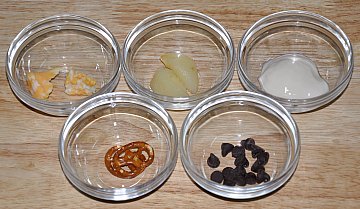
We had cheese, pears, yogurt, pretzel and chocolate chips for sampling.
Step 1: Blindfold whomever is doing the experiment and have them hold their nose so they can't smell the food.
Step 2: Have them predict what each food is as they taste it. Right down their answer.
Step 3: Take off the blindfold and compare the results.
Your senses work together. You use your sense of smell when tasting different flavors. So when you can't see the food or smell it, oftentimes you can't guess what you are eating.
This is why when you have a cold or you are sick foods often taste different.
Making Sugar Crystals
To form sugar crystals you will need:- 1 teaspoon sugar
- 3 Tablespoons water
- food coloring
- small bowls
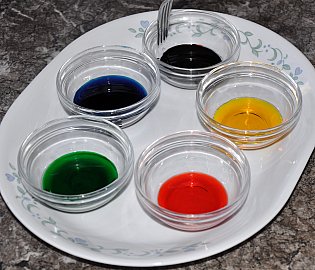
Let set 2-4 days.
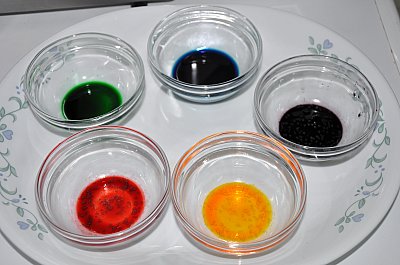
The water in your bowls will evaporate little by little each day and leave sugar crystals behind.
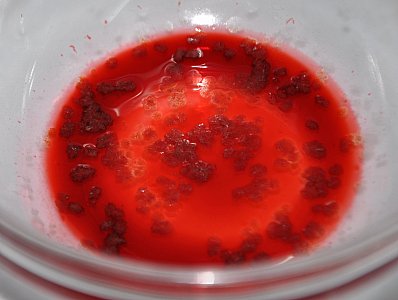
More Younger Chef Food Science Activities
Apple experimentBean experiments
Celery and Food Coloring Experiment
Cheese Souffle
Homemade butter
Homemade volcano
Jumping raisins
Poached egg
Shiny coins
Turn an egg into a rubber ball
Older Chefs Food Science Experiments
How to Make Cottage Cheese
Here are directions and pictures on
how to make cottage cheese. Did you ever wonder what curds and
whey is? You'll also discover here what exactly curds and whey
are. This is a simple method that tastes great and saves money.
To make homemade cottage cheese, you will need:
- 1 quart milk
- 1/4 cup vinegar
- pinch of salt
Step 1: Pour your milk in a saucepan and using a thermometer heat to 190 degrees F.
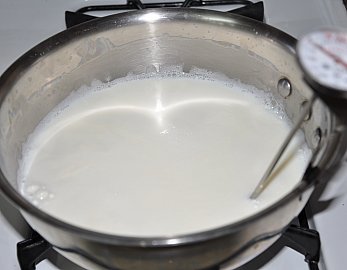
Step 2: Take milk off heat once it reaches 190 degrees and stir in vinegar.
Step 3: Let cool.
Step 4: With a strainer drain the whey, which is the liquid, off the curds, which is the cottage cheese.
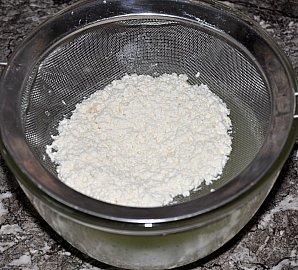
Step 5: You can throw out the whey or use it for cooking.
Step 6: Add a pinch of salt to your cottage cheese and its ready to eat.
Step 7: If you like your cottage cheese creamy, stir in a tablespoon orless of cream.
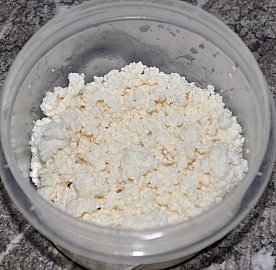
Science behind Cottage Cheese Making
When you add vinegar it separates the proteins in the milk which
makes curds and whey.Red Cabbage Ph Experiment Steps
- You need red cabbage leaves chopped.
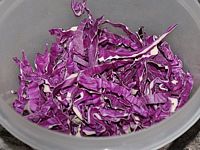
- Place cabbage in a bowl and pour boiling water over the top.
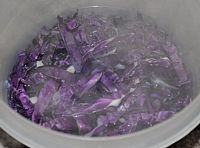
- Let cool.
- Drain cabbage and discard cabbage. Save the cabbage water.
- Take a note of the color of the water.
- Pour cabbage water in several small bowls.
- Find several different food items in the kitchen you'd like to
test.
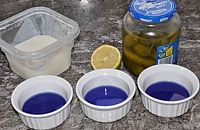
We did this experiment with homemade yogurt, lemon juice and pickle juice. - Drop a spoonful of a different food in each bowl and take note
of the results.

Here are our results.
More Cabbage Experiment Results
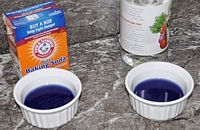
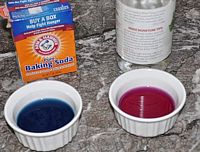
Baking soda is a base so the water turns blue. Vinegar is an acid so the water turns pink.
More food science experiments for older chefs
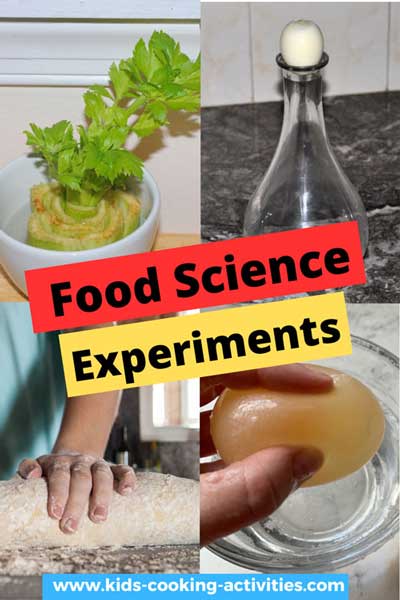 Egg into a bottle
Egg into a bottleHomemade ice cream in a can or bag
How is chocolate made?
Make homemade yogurt
Proofing yeast and baking homemade bread
Sourdough bread starter recipe
Turn an egg into a rubber ball
Grow your own Experiments
Bean PlantCarrot Top
Avocado Plant
Celery Stalk Experiment
Onion Sprouting
Pineapple Growing
Grow your own food from scraps
Related Food Science Experiment Pages: ~ Apple experiments, ~ Bean experiments, ~Celery and Food Coloring, ~ Homemade butter, ~Make Cottage Cheese, ~Red Cabbage PH ~Homemade volcano, ~Coke Bottle Experiment, ~ Jumping raisins , ~Cheese Souffle, ~ Poached egg, ~ Shiny coins, ~ Egg into a bottle, ~ Homemade ice cream in a can or bag, ~ How is chocolate made?, ~ Make homemade yogurt, ~ Proofing yeast and baking homemade bread, ~ Sourdough bread starter recipe, ~Grow your own from food scraps, ~Food Science
More Kids Cooking Activities
You could start with 20 ways to cook with your children. 70 simple kids cooking activities list. Or here are some different ideas to help you get started cooking!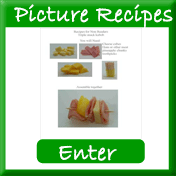

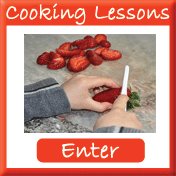


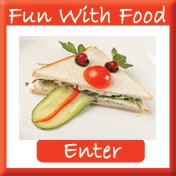

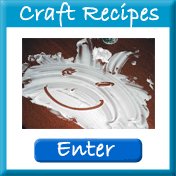
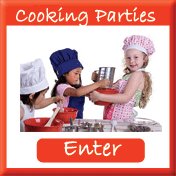
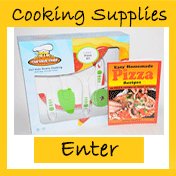
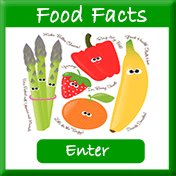
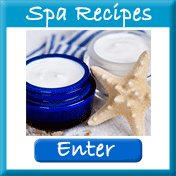



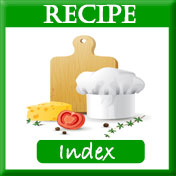


Do you have a Food Science Experiment or Activity?
Share your kids science experiment!
What Other Visitors Have Said
Click below to see contributions from other visitors to this page...
Importance of Washing Hands 




As our class was discussing how to safely prep food and cook together we talked about why we should wash our hands before and after handling food items. …
Growing Lettuce Not rated yet
I teach at a Christian school. So we discuss how God made things. When doing the lettuce experiment, I use romaine lettuce.
The experiment is …
Turn an Uncooked Egg into a Rubber Ball Not rated yet
Needed materials: uncooked egg (Make sure the eggshell isn't cracked.) clear container with lid big enough for the egg and vinegar
Directions: …
How to Make Butter- Kids Science Activity Not rated yet
Pour some heavy whipping cream into a small jar with lid. Fill about halfway full. Let the cream come to room temperature. Begin shaking your cream in …
Celery and Food Coloring Experiment Not rated yet
For this food science experiment you'll need: Celery stalks with leaves still attached on the end Jars Food coloring Water Directions: Add drops of …
Egg Floating Experiment Not rated yet
First the materials needed are
2 eggs
1 glass of water
1 glass of water mixed with 3-4 tablespoons salt
Put one egg in water and another egg …
Follow Kids Cooking Activities






